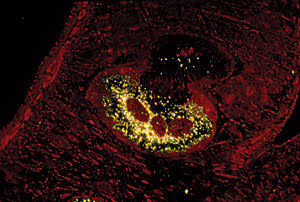Jill Dreschler, Leica Microsystems Inc.
Automated microscopy in the life sciences can trace its beginnings to the semiconductor industry. In the 1970s, automated microscope stages were developed and used extensively for wafer inspection in semiconductor fabrication. By grafting motorized components onto a microscope designed for manual use, automation was achieved. Over time, more functionality became internal to the microscope.
By the 1990s, microscopes with automated internal controls were commercially available for the life sciences laboratory. A researcher could purchase a microscope with controls that motorized stage movement, the changing of nosepieces and Z focus. In many ways, this early technology was automation without a clear-cut application. The microscope was motorized, but the software to control it was limited in what it could do.
By the mid-90s, usage of GFP became popular and brought with it a demand to track cellular functions with time-lapse imaging. At the same time, digital photography was more commonly used, and software gained the ability to control the microscope in a way that allowed sophisticated experiments to be performed automatically. These developments led the way to digital microscopy.

Digital microscopy enables complex biological experiments. This fluorescence image shows a section of a worm. Courtesy of Leica Microsystems Inc.
Digital microscopy represents a blending of digital photography designed to rapidly capture low-light images and software to drive the microscope and to process large amounts of imaging data. The technology is moving toward tighter integration of hardware and software to create one system in which they work together seamlessly.
Integrated microscopes and software share more information, which leads to less user intervention, less room for error and clearer documentation of the experimental conditions. For example, some microscopes are coded so that the software recognizes the objective and the fluorescence cube that are in place. Some system integration even goes so far as to identify the point spread function for the objective in use to enable iterative deconvolution of a captured data set with the simple press of a button.
Automation currently is pushing past simple motorization, making microscopy techniques faster and more reproducible, as well as easier for the expert and novice alike. Researchers can switch between contrast methods such as transmitted light phase contrast and epifluorescence by pressing a button. For each technique, the necessary components are inserted or removed from the light path, and the user’s optimized settings, such as fluorescence intensity and field and aperture diaphragm selection, can be restored.
Microscopes with this type of automation are very user friendly. Although some functions have been available for some time in the most highly automated research microscopes, these capabilities more recently have been extended to enhance and transform microscopes that have traditionally been thought of as fully manual.
This technology can be found on even the most basic fluorescence microscopes, which decreases the experiment time, increases reproducibility and provides ease of use. Researchers using traditional manual microscopes in multiuser environments can benefit from automation that can store and recall individual user settings. Retrieval of settings can make a shared microscope feel like a personal microscope and is ideal for users who have different skill levels.
Digital microscopy is here, and more advances are on the way. One intriguing possibility is the integration of an “intelligent” microscope with image archiving, in which a click on an archived image would cause the instrument to automatically configure itself to the settings used to capture that image. This would reduce the training time required for novices to perform advanced microscopy, improve the work flow of experienced users by quickly restoring their finely tuned, optimal settings, and provide excellent reproducibility.
Meet the author
Jill Dreschler is product manager for microscopy at Leica Microsystems Inc. in Bannockburn, Ill.; e-mail: [email protected].